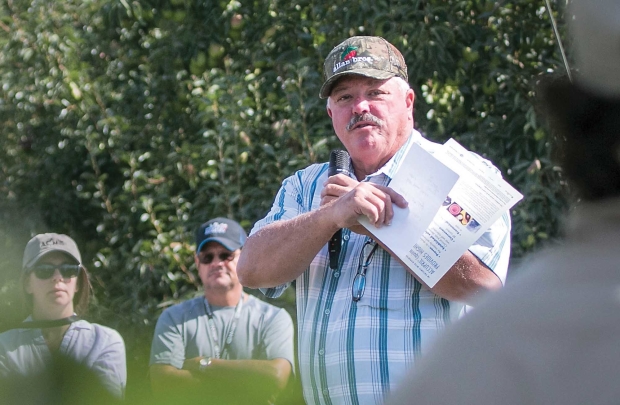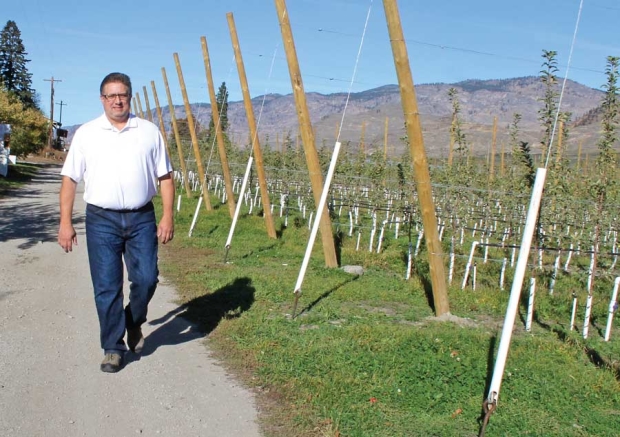As the cost of labor increases, industries typically find ways to use less of it.
But the tree fruit industry is an exception, Wapato, Washington, grower Jim Doornink said during a panel discussion at the Washington State Tree Fruit Association’s Annual Meeting in December.
Over the past 25 years, fruit growers have been needing more labor to produce fruit, despite the increasing costs.
“Labor is a huge portion of our costs,” said Doornink, who farms 250 acres of cherries, apricots, pears and apples. “We’ve finally come to the point where we realize it has to stop, and we’re doing more and more every year to bring technologies in.”

Jim Doornink at one of his orchards near Parker, Washington, on July 16, 2015. (TJ Mullinax/Good Fruit Grower)
Growers have made changes to their trellises and growing systems. They’re using netting and evaporative cooling to protect fruit from the sun, and advances have been made in spray application technology. But there have not been major changes that reduce the labor input.
“The changes that come along are incremental changes,” Doornink said. “And sometimes incremental changes freeze you in position because you feel comfortable about the things you’ve learned and done. Instead, you should be looking to the future and what’s going to be done.”
Doornink recalled that when he joined the Washington Tree Fruit Research Commission’s board 30 years ago, he was advised: “Be not the first by which the new is tried, nor the last to lay the old aside.” Others have cautioned about the risks of being on the “bleeding” edge.
“We need to be sure we’re not the ones who are bleeding or the ones who get left behind,” he said. “It’s very important that the technologies we adopt, we adopt from other industries. You have to be looking all the time.”
New technology is not a toy if it makes money, he added, but often growers try to make their toys make money for them.
“I want a drone in the worst way,” he added. “I don’t want a tiny one that sits in my hand. I want a big one with shiny stuff on it, and I want one with lights on it, but I can’t figure out how to put it in my ranch budget and have it make money for me right now.”
Financial stretch
Sam Godwin, who farms 200 acres of apples, pears and cherries in the Tonasket area of north central Washington, said that, for small growers, the decision to spend money on new technology is a difficult one. “We don’t have large budgets, so we have to make every dollar count as much as we can.”

Sam Godwin walks in his orchard in Ellisforde, Washington in 2015. (Geraldine Warner/Good Fruit Grower)
Even buying something like a tractor at today’s prices is a financial stretch, he said, and growers must consider whether new equipment will fit into their orchards.
“We’re farming old ground,” he said. “I have orchards that are a hundred years old. A hundred years ago, they didn’t think of these things. We have big canopies and limited spaces. We’re looking at our orchards and trying to figure out how fast can we change architecturally to get to a critical mass where some of this technology fits. These are hard decisions to make.”
Godwin has a regular renewal program, planting some new orchard every year to stay updated while spreading out the capital investment. This also helps him keep current with the costs of trees, posts and wires, for example.
“If you’re not doing it on a regular basis, it’s hard to budget and to get information, especially when you’re isolated up in the north away from the bigger chunk of the industry,” he said. “One of the advantages of farming in the north is that there are no giant neighboring orchards competing for labor and other resources.
“But that’s changing,” he added. “The marijuana industry is taking off, and I think in the future that could be a competition for resources.”
Godwin is hoping that by the time robotic harvesting becomes available within the next few years, he will have converted enough of his orchard to the right structure that automated harvesting will make sense for his operation. “It’s something we’re excited about,” he said.
Vertical systems
Mark Hanrahan, a cherry and pear grower in Buena, Washington, said mechanical harvesting is possible for cherries already, but only if the grower is willing to try to market them without stems.
A mechanical harvester developed about 15 years ago by Dr. Don Peterson with the U.S. Department of Agriculture was designed for angled canopies. Cherries were loosened from their stems with Ethrel (ethephon) applications and would fall into the harvester’s catching frame when the trees were shaken.
Hanrahan, who will plant his first apple block next year, emphasized that platforms and other mechanical aids must be versatile so small growers with limited capital can use them for multiple orchard operations.
He’s working toward having trees on vertical systems so they can be mechanically pruned and harvested. He believes a robotic harvester under development, which vacuums fruit from the trees, is a game changer and will require a vertical canopy.
Capital budget
Doornink asked the other panelists how they handle their capital budget and commented that he finds it a scary thing to put together a five-year capital budget with all the things he wants to do and their associated cost.
Mark Stennes, who grows apples, pears and cherries with his family in Okanogan County, said he is moving from a labor-oriented budget to more of a capital budget, shifting from 65 percent for labor to 65 percent for equipment and technology. For the past 10 years he has been working to ensure their plantings will be conducive to robotics.
Stennes said his father, Keith, and brother, Kevin, who are partners in the business, asked him last spring for a five-year capital budget.
He put together a wish list that almost gave them a heart attack, he joked. There must be good harmony between the finance and operational sides of the business and shared goals, he stressed. Plans must be made five to 10 years ahead because nursery trees have to be ordered up to five years ahead of time, and it can be another five years before they come into full production.
Godwin said several years ago he began making annual lists of proposed activities and acquisitions based on where he felt he needed to make changes and how soon. His plan took into account how big his operation could get before he had to build additional housing or when he would need to plant on lower ground that would require a wind machine.
“Whatever plan we settle on, it has to pay its own way,” he emphasized. “It’s not like I have a big stash of money somewhere. It has to pencil out at the end of the day.” •
– by Geraldine Warner






Geraldine, great to see your byline!